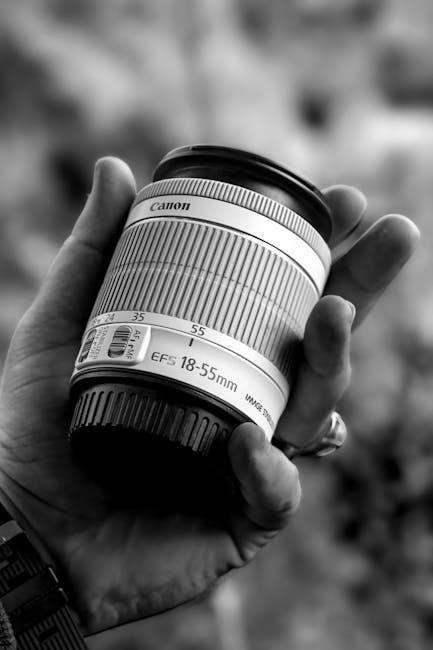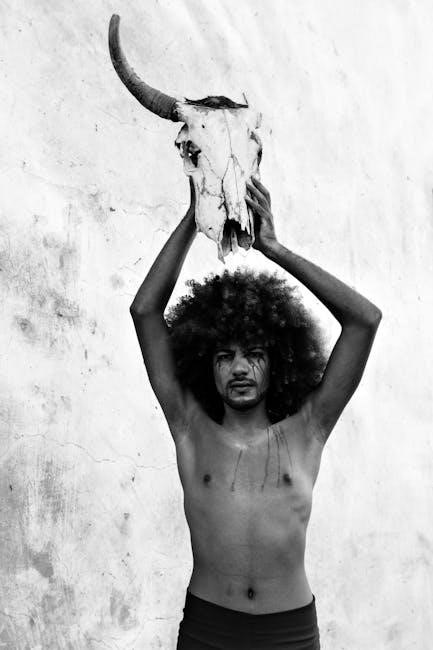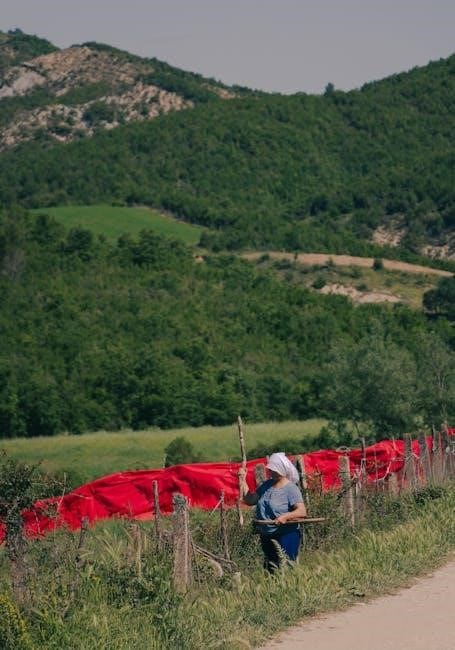The Canon EOS 70D is a versatile DSLR camera featuring a 20.2 MP APS-C CMOS sensor, Dual Pixel CMOS AF, and advanced video capabilities.
1.1 Overview of the Camera
The Canon EOS 70D is a high-performance DSLR camera designed for both enthusiasts and professionals. It features a 20.2 MP APS-C CMOS sensor, delivering sharp and detailed images. Equipped with the DIGIC 5 image processor, it ensures fast operations and excellent image quality. The camera boasts advanced features like Dual Pixel CMOS AF for smooth autofocus, a vari-angle touchscreen for intuitive control, and built-in Wi-Fi for easy image sharing and remote control. Its robust design and ergonomic build make it ideal for versatile photography and videography needs.
1.2 Importance of the Instruction Manual
The instruction manual is essential for mastering the Canon EOS 70D. It provides detailed guidance on camera setup, advanced features, and troubleshooting. Understanding the manual ensures optimal use of the Dual Pixel AF, vari-angle touchscreen, and built-in Wi-Fi. It also covers customization options, maintenance tips, and error resolution, helping users unlock the camera’s full potential for professional-grade photography and videography. Regularly referencing the manual allows photographers to explore and utilize all available functions effectively.
Camera Specifications
The Canon EOS 70D features a 20.2 MP APS-C CMOS sensor, DIGIC 5 processor, and Dual Pixel AF for superior autofocus in video and Live View modes.
2.1 Key Features of the Canon EOS 70D
The Canon EOS 70D stands out with its 20.2 MP APS-C CMOS sensor, DIGIC 5 image processor, and Dual Pixel CMOS AF technology, enabling fast and precise autofocus during video recording and Live View shooting. It also features a vari-angle 3.0-inch touchscreen LCD with Touch AF, built-in Wi-Fi for seamless connectivity, and an ISO range of 100-12800, expandable to 25600. The camera supports Full HD video recording at 1080p and offers continuous shooting up to 7.0 fps, making it ideal for both still photography and videography. Additionally, the Intelligent Viewfinder provides a clear and customizable shooting experience, while the 19 cross-type AF points ensure accurate and flexible autofocus performance. These features collectively make the EOS 70D a powerful tool for photographers seeking high-quality images and advanced functionality.
2.2 Technical Details and Capabilities
The Canon EOS 70D is equipped with a 20.2-megapixel APS-C CMOS sensor and a DIGIC 5 image processor, delivering high-resolution images and efficient processing. It supports Full HD video recording at 1080p with Movie Servo AF and features a 3.0-inch vari-angle touchscreen LCD. The camera offers a wide ISO range of 100-12800 (expandable to 25600) and continuous shooting up to 7.0 fps. Built-in Wi-Fi enables wireless image transfer and remote camera control, while the 19 cross-type AF points ensure precise autofocus performance. Additionally, the EOS 70D supports 3-10x Movie Digital Zoom and features Scene Intelligent Auto Mode for enhanced versatility.

Camera Design and Ergonomics
The Canon EOS 70D features a durable, weather-sealed body with an ergonomic grip for comfortable handling. Its vari-angle touchscreen LCD offers flexible shooting angles and intuitive control.
3.1 Exterior and Build Quality
The Canon EOS 70D boasts a robust, weather-sealed body made of aluminum alloy and polycarbonate, ensuring durability and lightweight handling. Its ergonomic design provides a comfortable grip, reducing fatigue during extended use. The camera features a vari-angle 3.0-inch touchscreen LCD with multi-touch capabilities, offering flexibility in shooting from various angles. The weather-sealed construction protects against dust and moisture, while the intuitive menu system ensures easy navigation of settings and features.
3.2 Layout of Controls and Buttons
The Canon EOS 70D features a well-organized layout of controls and buttons, designed for intuitive operation. The mode dial on the top provides quick access to shooting modes, while the main dial and quick control dial allow for easy adjustments of aperture and shutter settings. Customizable buttons enable personalized control, and the vari-angle touchscreen offers touch-based navigation and focus selection. This ergonomic design ensures seamless handling and efficient access to key functions during photography and video recording.
Operating Modes
The Canon EOS 70D offers a range of shooting modes, including Scene Intelligent Auto, Creative Filters, and manual modes, catering to both beginners and advanced photographers.
4.1 Understanding Different Shooting Modes
The Canon EOS 70D offers a variety of shooting modes to suit different photography needs. Scene Intelligent Auto mode simplifies capture by automatically adjusting settings. Creative Filters enable artistic effects like Grainy B&W or Miniature. Manual modes (M, Av, Tv, P) provide full control for advanced users. These modes ensure versatility, catering to both beginners and professionals, and enhance creativity in various shooting scenarios;
4.2 Customizing Shooting Modes
The Canon EOS 70D allows users to customize shooting modes to suit their preferences. Custom Shooting Profiles can be saved for quick access, enabling photographers to tailor settings like aperture, shutter speed, and ISO. Additionally, the camera permits assigning specific functions to buttons, streamlining workflow. This level of customization enhances flexibility, making it ideal for both professional and enthusiast photographers. The ability to adapt modes ensures optimal performance in diverse shooting conditions.

Autofocus System
The Canon EOS 70D features Dual Pixel CMOS AF, offering fast and precise autofocus performance, especially in video and Live View modes with enhanced subject tracking.
The Canon EOS 70D features Dual Pixel CMOS AF, a revolutionary autofocus technology that enables fast and precise focusing. This system uses phase-detection directly from the camera’s image sensor, providing smooth and accurate autofocus performance, especially during video recording and Live View shooting. Dual Pixel CMOS AF allows for continuous focus tracking of moving subjects and delivers superior results in challenging lighting conditions, making it ideal for both still photography and video production.
5.2 Configuring Autofocus Settings
The Canon EOS 70D allows users to customize its autofocus system for optimal performance. Through the menu, you can select AF modes such as One-Shot AF for stationary subjects or AI Servo AF for moving subjects. The camera also offers 19 cross-type AF points, which can be manually selected or set to auto mode. Additionally, AF sensitivity and acceleration/deceleration tracking can be adjusted to suit specific shooting scenarios, ensuring precise focus control in various conditions.
5.3 Using Autofocus in Video Mode
The Canon EOS 70D’s Dual Pixel CMOS AF enhances autofocus during video recording, providing smooth and quiet focusing. Movie Servo AF allows continuous focus tracking of moving subjects. Users can enable face detection and tracking for precise subject monitoring. The vari-angle touchscreen enables Touch AF, making it easy to adjust focus points during filming. These features ensure sharp, professional-grade video recordings with minimal manual intervention, even in dynamic shooting environments.

Live View and Video Recording
Engage Live View mode for real-time preview on the vari-angle touchscreen. The Canon EOS 70D excels in video recording with Dual Pixel CMOS AF, ensuring sharp focus and smooth transitions during filming.
6.1 Activating and Using Live View
To activate Live View on the Canon EOS 70D, press the dedicated Live View button located on the back of the camera. This mode provides a real-time preview of your scene on the 3.0-inch vari-angle touchscreen. Use the touchscreen to adjust settings, focus, and review images. The Dual Pixel CMOS AF ensures fast and accurate autofocus during Live View shooting. This feature is particularly useful for video recording and composing shots from unique angles. Familiarize yourself with the on-screen controls for seamless operation.
6.2 Best Practices for Video Shooting
For optimal video recording with the Canon EOS 70D, ensure the camera is stabilized using a tripod or handheld rig. Use the vari-angle touchscreen to frame shots from unique angles. Enable Movie Servo AF for smooth focus tracking, or switch to manual focus for precise control. Record in MP4 format for smaller file sizes or MOV for higher quality. Utilize external microphones for better audio and ensure memory cards are sufficiently large for extended shooting sessions. Regularly review footage to refine techniques and achieve professional-grade results.

Vari-Angle Touchscreen
The Canon EOS 70D features a 3.0-inch, 1,040k-dot vari-angle touchscreen, offering multi-touch functionality and Touch AF for intuitive operation. It allows shooting from various angles with ease.
7.1 Navigating the Touchscreen Interface
The Canon EOS 70D’s 3.0-inch vari-angle touchscreen offers intuitive navigation. Users can swipe through images, pinch to zoom, and access shooting settings. The interface supports multi-touch gestures, allowing quick adjustments to focus, exposure, and menu options. The touchscreen’s responsiveness enhances efficiency, enabling seamless transitions between shooting modes and playback. Its design ensures easy access to key functions, making it a user-friendly feature for both stills and video capture.
7.2 Using Touch AF for Focus Control
The EOS 70D’s Touch AF feature allows precise focus control. By tapping the touchscreen, users can select focus points quickly and accurately, even during video recording. This feature enhances creativity, enabling rapid shifts between subjects or compositions. The Dual Pixel CMOS AF ensures smooth and fast focusing, making Touch AF ideal for dynamic scenes. It simplifies capturing sharp images and videos, offering a modern approach to traditional autofocus methods.
ISO Settings and Noise Reduction
The EOS 70D offers an ISO range of 100-12800, expandable to 25600, ensuring low-light performance. The camera effectively manages noise at high ISO settings for clearer images.
8.1 Understanding ISO Sensitivity
ISO sensitivity determines the camera’s light sensitivity, ranging from 100 to 12800, with expansion to 25600. Lower ISOs (100-400) are ideal for bright lighting, while higher ISOs (6400-25600) are used in low-light conditions. The EOS 70D balances noise reduction at high ISOs, ensuring sharp images even in challenging lighting. Proper ISO adjustments enhance image quality, minimizing grain and digital noise, especially in dimly lit environments. Understanding ISO sensitivity is crucial for capturing professional-grade photos with optimal clarity and detail.
8.2 Managing Noise at High ISO Levels
High ISO levels on the Canon EOS 70D can introduce noise, especially in low-light conditions. The camera features built-in noise reduction to minimize grain and digital artifacts. For optimal results, use the noise reduction settings in the menu or apply post-processing software. Lowering ISO or using a tripod for longer exposures can also help maintain image clarity. Balancing ISO settings with lighting conditions ensures crisp, professional-quality photos even in challenging environments.
Intelligent Viewfinder
The Canon EOS 70D’s Intelligent Viewfinder offers a clear, real-time display of shooting settings, AF points, and frame lines, aiding precise composition and control.
9.1 Features of the Viewfinder
The Canon EOS 70D’s Intelligent Viewfinder provides a 98% coverage of the scene, ensuring accurate framing. It features a transparent LCD overlay that displays key shooting information such as AF points, grid lines, and horizon levels. The viewfinder offers 0.95x magnification for clear visibility and supports customization to suit individual preferences. Photographers can enable or disable specific overlays, like the electronic level or shooting mode icons, to enhance their shooting experience. This feature-rich design helps users maintain focus on their subject while easily monitoring camera settings.
9.2 Customizing Viewfinder Display
The Canon EOS 70D allows users to customize the viewfinder display to suit their preferences. Through the camera’s menu system, you can enable or disable specific overlays, such as the electronic level, grid lines, or shooting mode icons. This feature helps reduce clutter and allows photographers to focus on their subject. Additionally, the viewfinder’s LCD overlay can be adjusted to display only the information needed, ensuring a distraction-free shooting experience. This customization enhances workflow efficiency and personalizes the camera to individual shooting styles.

White Balance and Color Settings
The Canon EOS 70D’s White Balance and Color Settings allow users to adjust color tones and profiles to match lighting conditions and creative preferences accurately.
10.1 Understanding White Balance Options
The Canon EOS 70D offers various White Balance options to ensure accurate color reproduction. Auto White Balance automatically adjusts settings based on lighting conditions. Preset modes like Daylight, Shade, Tungsten, Fluorescent, and Flash provide optimal results in specific environments. Custom White Balance allows users to set a specific color temperature for precise control. Additionally, the camera supports color temperature settings from 2500K to 10000K, enabling fine-tuned adjustments. These options ensure images capture natural colors under diverse lighting scenarios.
10.2 Adjusting Color Profiles
The Canon EOS 70D allows users to adjust color profiles through its Picture Style settings. These predefined profiles—such as Standard, Portrait, and Landscape—offer tailored color, contrast, and sharpness. Users can customize these profiles by adjusting parameters like saturation and tone to match their creative vision. Additionally, the camera supports the creation of custom Picture Styles, enabling precise control over color rendering. These adjustments, combined with the DIGIC 5 processor, ensure high-quality image output tailored to individual preferences.

Customization and Personalization
The Canon EOS 70D offers extensive customization options, allowing users to tailor camera settings to their preferences for enhanced shooting efficiency and creativity.
11.1 Customizing Camera Buttons
The Canon EOS 70D allows users to customize camera buttons to suit their preferences, enhancing efficiency. Assign functions like AF, depth of field preview, or ISO to buttons such as the shutter button, aperture button, or M-Fn button. This customization is accessed via the Custom Functions menu, enabling photographers to tailor button roles for streamlined operation. By personalizing button functions, users can reduce time spent adjusting settings and gain quicker access to their most-used features during shoots. This feature is particularly beneficial for photographers with specific workflows or preferences, ensuring a more intuitive shooting experience.
11.2 Creating Custom Shooting Profiles
The Canon EOS 70D enables users to create custom shooting profiles, allowing for personalized settings tailored to specific photography scenarios. These profiles can be saved to the camera’s memory and accessed quickly, ensuring consistency and efficiency; By navigating to the camera’s menu system, users can define custom settings for ISO, white balance, autofocus modes, and more, storing them in one of three custom shooting modes (C1, C2, or C3). This feature is ideal for photographers who frequently switch between different shooting conditions, such as portraits, landscapes, or sports, providing a seamless transition between setups. Custom profiles streamline workflows, enhancing creativity and productivity during photo sessions. The ability to save and recall these profiles makes the EOS 70D highly adaptable to individual photographic styles and preferences. This level of customization ensures that photographers can focus on capturing moments rather than adjusting settings repeatedly. The saved profiles can also be updated or modified as needed, offering flexibility for evolving shooting needs. By leveraging custom shooting profiles, users can maximize the camera’s potential and tailor it to their unique requirements. This feature is a testament to the EOS 70D’s versatility and user-centric design, making it a powerful tool for both amateur and professional photographers. The process of creating and managing these profiles is straightforward, with clear menu options guiding users through each step. Whether shooting in controlled environments or dynamic outdoor settings, custom profiles empower photographers to maintain consistency and achieve desired results efficiently. The EOS 70D’s custom shooting profiles are a valuable asset for anyone seeking to personalize their photography experience and optimize their workflow.

Memory Card Management
The Canon EOS 70D supports SD, SDHC, and SDXC memory cards. Regular formatting ensures optimal performance and prevents data corruption, maintaining reliable storage for your images and videos.
12.1 Choosing the Right Memory Cards
For the Canon EOS 70D, selecting the right memory cards is crucial for optimal performance. The camera supports SD, SDHC, and SDXC cards, ensuring compatibility with various storage needs. When choosing a memory card, consider the storage capacity based on your shooting requirements. Faster cards (Class 10 or U3) are recommended for video recording and burst mode photography. Always ensure the card is compatible with the camera’s specifications to avoid performance issues during use.
12.2 Formatting and Maintaining Memory Cards
Regular formatting of memory cards in your Canon EOS 70D ensures optimal performance and prevents errors. Always format cards in the camera rather than on a computer to maintain compatibility. Use a high-quality card reader for transferring images to your device. Store cards in protective cases to avoid damage and data loss. Before formatting, ensure all important data is backed up, as formatting will erase all content on the card.

Built-In Wi-Fi Connectivity
The Canon EOS 70D features built-in Wi-Fi for easy image sharing and remote camera control via smartphones or tablets, enhancing connectivity and shooting flexibility.
13.1 Setting Up Wi-Fi for Image Transfer
Setting up Wi-Fi on the Canon EOS 70D enables seamless image transfer to smartphones, tablets, or computers. Use the Canon Camera Connect app to establish a connection. Ensure the camera’s Wi-Fi is enabled, select the network, and follow in-app instructions. This feature allows wireless transfer of photos and videos, making sharing convenient. The process is straightforward, requiring minimal setup and ensuring secure data transfer with encryption support.
13.2 Remote Camera Control via Wi-Fi
Remote camera control via Wi-Fi allows photographers to operate the Canon EOS 70D from a smartphone or tablet. Using the Canon Camera Connect app, users can adjust settings like aperture, shutter speed, and ISO. This feature is ideal for shooting in challenging positions or group photos. The app also enables live view monitoring, ensuring precise composition and focus. Remote control enhances creativity and convenience, making it a valuable tool for both amateur and professional photographers.
Maintenance and Care
Regularly clean the camera and lens with a soft cloth to prevent dust and smudges. Update firmware to ensure optimal performance and security of your Canon EOS 70D.
14.1 Cleaning the Camera and Lens
Use a soft, dry cloth to gently wipe the camera body and lens, avoiding harsh chemicals. For the lens, apply a microfiber cloth and lens cleaning solution. Use a blower to remove loose dust from the sensor and mirror. Avoid touching the sensor; if necessary, use a swab with cleaning solution. Regular cleaning ensures optimal image quality and prevents damage. Always store the camera in a dry, cool place to prevent moisture buildup. Check for firmware updates to maintain peak performance.
14.2 Updating Firmware
Regularly updating your Canon EOS 70D’s firmware ensures optimal performance, security, and compatibility. Use the EOS Utility software via USB connection to download and install the latest firmware from Canon’s official website. Ensure the camera’s battery is fully charged and avoid interruptions during the update process. Firmware updates often add new features, improve autofocus accuracy, and fix known issues. Always verify the update source to prevent unauthorized software installations. This helps maintain camera functionality and ensures you have the latest enhancements. Follow on-screen instructions carefully to complete the update successfully.

Troubleshooting Common Issues
Troubleshoot common issues like error messages or connectivity problems by checking camera settings, ensuring proper connections, and restarting the device. Consult the manual for detailed solutions.
15.1 Resolving Error Messages
Encounter error messages? Start by checking camera settings and connections. Ensure memory cards are properly formatted and clean the sensor if errors persist. For lens-related issues, detach and reattach the lens. If problems remain, restart the camera or reset to default settings. Refer to the manual for specific error code solutions. Updating firmware or consulting Canon support may also resolve persistent issues, ensuring optimal camera performance. Always follow the manual’s troubleshooting guide for detailed instructions.
15.2 Addressing Connectivity Problems
Experiencing connectivity issues with your Canon EOS 70D? Start by restarting the camera and ensuring Wi-Fi is enabled. Check that the camera is connected to the correct network and that the signal strength is adequate. If problems persist, reset the Wi-Fi settings or update the firmware to the latest version. For remote shooting or image transfer, ensure the EOS Utility software is installed on your device. Refer to the manual for detailed steps to resolve connectivity problems effectively.
The Canon EOS 70D delivers exceptional performance, combining advanced features like Dual Pixel AF and built-in Wi-Fi. Refer to the manual for optimal use and experiment with settings to enhance your photography and videography experience.
16.1 Summary of Key Features
The Canon EOS 70D features a 20.2 MP APS-C CMOS sensor, Dual Pixel CMOS AF for smooth focusing, and a DIGIC 5 image processor. It offers 19 cross-type AF points, a vari-angle touchscreen, and an ISO range of 100-12800 (expandable to 25600). Built-in Wi-Fi enables easy image sharing and remote control. The camera supports 1080p Full HD video recording with Movie Servo AF and a 7.0 fps continuous shooting mode. These features combine to deliver high-quality images and intuitive control, making it a powerful tool for photographers and videographers alike.
16.2 Final Tips for Getting the Most Out of Your Canon EOS 70D
To maximize your experience with the Canon EOS 70D, familiarize yourself with its advanced settings and experiment with different shooting modes. Regularly update your firmware and customize camera buttons to streamline your workflow. For optimal results, understand ISO sensitivity and noise reduction techniques; Additionally, leverage the vari-angle touchscreen for intuitive focus control and image review. Finally, explore the built-in Wi-Fi capabilities for seamless image sharing and remote shooting to enhance your creativity and efficiency behind the lens.
